Perseid Meteor Shower 2013
In 2013, the Perseid meteors will streak across the short summer nights – August 10-13 – from late night until dawn, with little to no interference from the waxing crescent moon.
Plus the moon will be near the planet Saturn in the evening hours, giving a colorful prelude to late-night Perseid show.
Best mornings to look: August 11, 12 and 13.

The Perseid meteor shower is perhaps the most beloved meteor shower of the year for the Northern Hemisphere
The Perseid meteor shower is perhaps the most beloved meteor shower of the year for the Northern Hemisphere.
The shower builds gradually to a peak, often produces 50 to 100 meteors per hour in a dark sky at the peak, and, in the Northern Hemisphere, this shower comes when the weather is warm.
The Perseids tend to strengthen in number as late night deepens into midnight, and typically produce the most meteors in the wee hours before dawn. They radiate from a point in the constellation Perseus the Hero, but, as with all meteor shower radiant points, you don’t need to know Perseus to watch the shower; instead, the meteors appear in all parts of the sky.
They are typically fast and bright meteors. They frequently leave persistent trains. Every year, you can look for the Perseids around August 10-13. They combine with the Delta Aquarid shower to produce the year’s most dazzling display of shooting stars.
[youtube zeNQT-1mTko]

